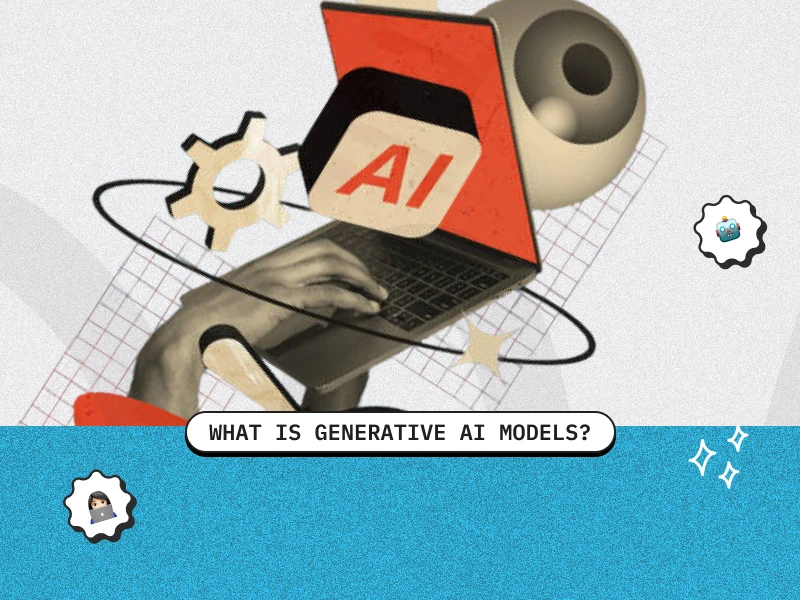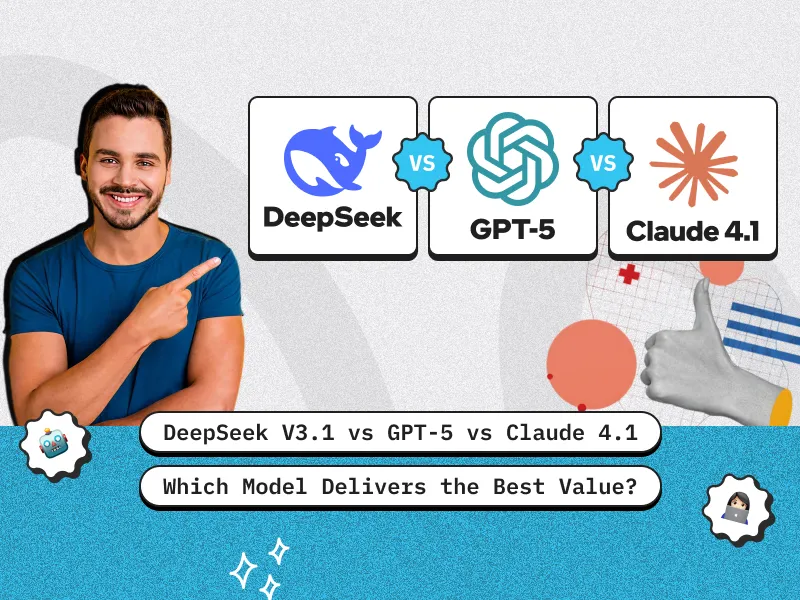TL;DR
- Understand what Generative AI Models are and how they differ from traditional AI systems.
- Explore various types of generative ai models like GANs, LLMs, VAEs, Diffusion, and Multimodal models.
- Discover real-world examples, including open-source and enterprise-grade generative artificial intelligence models dominating 2025.
- Learn how these models work—from training and inference to prompt engineering and fine-tuning.
- Get guidance on selecting the right model with insights from a leading Generative AI Development Company.
Generative AI Models create original content like text, images, and music by learning from existing data. Notable examples include GPT-4 Turbo, Claude 3, Gemini 1.5, and Stable Diffusion. These models include GANs, transformers, VAEs, and diffusion models. Open-source models are growing in popularity for cost-effective solutions. For tailored performance, partnering with a Generative AI Development Company is key.
Introduction
Generative AI has rapidly evolved from a tech trend to a core innovation driver across industries. From producing hyper-realistic images and videos to writing personalized marketing copy and generating custom code, Generative AI Models are reshaping how businesses operate in 2025.
But what exactly are these models? How do they work? And more importantly—how do you choose the right one for your business needs?
In this guide, we’ll break down the fundamentals of generative artificial intelligence models, explore the latest advancements, and help you understand how these models can be applied in real-world use cases. Whether you’re a startup exploring AI possibilities or an enterprise looking for custom-built solutions, partnering with an experienced Generative AI Development Company can make all the difference in leveraging this technology effectively.
What are Generative AI Models?
Generative AI models are deep learning systems trained to generate content that mimics human-created data. Unlike traditional AI, which focuses on predictions and classifications, Generative AI Models produce new, original outputs—like writing essays, designing product images, composing music, or even simulating human voices.
This innovation is a major shift in the AI landscape. If you’re still comparing the two, check out this guide on ai vs generative ai to understand the key differences.
How Does the Generative AI Model Work?
Generative AI models are designed to create new, original content based on patterns learned from massive datasets. They are trained on diverse sources, such as text, images, audio, and more, enabling them to learn the structure, tone, and intricacies of the material. Once trained, these models can generate content that mirrors the original dataset in style, coherence, and context. Several key components drive this process:
1. Pretraining and Fine-tuning
Generative AI models undergo a two-step training process. First, pretraining involves feeding the model large volumes of data, allowing it to learn fundamental patterns and relationships. This gives the model a general understanding of the data. Then comes fine-tuning, where the model is refined using more specific, domain-related datasets to ensure it generates more relevant and accurate outputs for particular use cases, such as business applications, customer support, or creative writing.
2. Reinforcement Learning with Human Feedback (RLHF)
After the initial training phase, many generative AI models undergo Reinforcement Learning with Human Feedback (RLHF). In this phase, the model generates output based on user input, and human evaluators provide feedback on the quality, accuracy, and relevance of the generated content. This iterative feedback loop helps fine-tune the model further, ensuring it learns to produce more human-like and contextually appropriate results over time.
3. Prompt Engineering
Prompt engineering involves crafting the right inputs for the model to generate the most accurate or creative outputs. By carefully designing the prompts, users can guide the AI to produce content that aligns with their needs. For example, a prompt asking a language model to generate a formal email will yield different results compared to a casual one. Effective prompt engineering ensures that the generated content meets the desired tone and structure.
4. Tokenization and Attention Mechanisms
At the core of many generative models, particularly transformer-based architectures, lies tokenization and attention mechanisms. Tokenization breaks down text into smaller units, or “tokens,” such as words or subwords, allowing the model to process language efficiently. The attention mechanism enables the model to focus on important parts of the input when generating outputs, helping it prioritize context over irrelevant information. This mechanism is key for generating coherent, contextually accurate content, especially in tasks like text generation or machine translation.
5. Transformer Architecture
The backbone of many modern generative AI models is the transformer architecture. Transformers are highly efficient in handling vast amounts of data by processing sequences of information in parallel rather than sequentially, as traditional models did. This enables them to learn complex relationships and dependencies in data, making them particularly effective for tasks like language modeling, image generation, and more. Transformer models, such as GPT-4 and BERT, have revolutionized AI by making it possible to generate high-quality outputs in real-time.
Types of Generative AI Models
Here’s an attractive table summarizing the different types of Generative AI Models:
| Generative AI Model | Description | Key Use Cases |
| Generative Adversarial Networks (GANs) | Consists of two neural networks (generator and discriminator) that compete to improve content generation. | Image generation, video synthesis, art creation, deepfake generation |
| Transformer-based Models | Models like GPT-4 and BERT, which process and generate sequences of data, excelling in language tasks with attention mechanisms. | Text generation, language translation, content summarization |
| Variational Autoencoders (VAEs) | A type of autoencoder that learns a probabilistic distribution of the input data, allowing for the generation of new data points. | Image generation, anomaly detection, data compression |
| Diffusion Models | These models start with random noise and progressively denoise it to generate content, known for their high-quality image generation. | Image synthesis, inpainting, noise removal |
| Unimodal Models | Generate content from a single mode of data, such as text, images, or audio. | Text-based applications, image-based applications |
| Multimodal Models | Capable of generating content across multiple modes (e.g., text, images, and audio) simultaneously. | Multimodal content generation, cross-modal data synthesis |
| Large Language Models (LLMs) | Huge models like GPT-4 that are trained on vast text datasets to generate human-like language. | Chatbots, content creation, language translation |
| Neural Radiance Fields (NeRF) | A model for generating 3D scenes and photorealistic images by capturing light rays and spatial information. | 3D rendering, AR/VR applications, game design |
Examples of Popular Generative AI Models
Generative AI models have made remarkable advancements, each offering unique capabilities to generate content across various formats. Here are some of the most popular generative AI models:
1. GPT-4 Turbo (OpenAI)
GPT-4 Turbo is a powerful language model capable of generating text, performing reasoning tasks, and even writing code. It excels in content creation, conversational AI, and problem-solving with improved efficiency compared to earlier models.
2. Claude 3.7 (Anthropic)
Claude 3.7 Sonnet is already there. Developed by Anthropic, Claude 3.7 focuses on ethical alignment and safety while performing natural language tasks. It ensures unbiased responses and is ideal for sensitive applications, such as legal, medical, or customer service-related tasks.
3. Gemini 2.5 (Google DeepMind)
Gemini 2.5 is a multimodal model that can generate both text and images. It brings versatility to content creation by processing multiple data types simultaneously, ideal for tasks that require text-to-image generation and more.
4. Sora (OpenAI)
Sora is a cutting-edge model capable of converting text to video. This opens up new possibilities for content creators, allowing them to generate videos based on textual descriptions—ideal for marketing, educational, and entertainment purposes.
5. Mistral & LLaMA 4 (Open-source LLMs)
Both Mistral and LLaMA 3 are open-source large language models (LLMs) that provide flexibility and customization. These models are particularly useful for developers and businesses looking to fine-tune AI solutions for specific needs.
These models showcase the breadth of generative AI’s capabilities, offering solutions for a wide array of industries and use cases.
Comparison of Generative AI Models
| Model Type | Strengths | Example Models | Applications |
| Autoregressive | Strong at sequential data generation | GPT-4, LLaMA 3 | Text, code, forecasting |
| Diffusion | High-fidelity image synthesis | Stable Diffusion, DALL·E 3 | Art, 3D models |
| GANs | Sharp images, fast training | StyleGAN3, BigGAN | Vision, augmentation |
| VAEs | Interpretable latent space, stable training | VAE, Beta-VAE | Anomaly detection, denoising |
| Flow-Based | Exact likelihoods, invertible transformations | RealNVP, Glow | Molecular modeling, density estimation |
Open-Source Generative AI Models
LLaM 4 by Meta
Meta’s LLaMA 3 is an advanced language model offering sizes ranging from 8B to 70B parameters, suitable for various natural language processing tasks.
Explore LLaMA 4
Mistral
Mistral provides customizable, open-source large language models that can be deployed across different platforms, offering flexibility for developers and businesses.
Visit Mistral
Falcon
Developed by the Technology Innovation Institute, Falcon is an open-source large language model known for its efficiency and performance in various AI applications.
Learn about Falcon
Stable Diffusion
Stable Diffusion is a deep learning, text-to-image model that generates high-quality images from textual descriptions, with its code and model weights publicly available.
Access Stable Diffusion
Choosing the Right Generative AI Model
When selecting a generative AI model, consider the following key factors:
1. Business Goals: Text vs. Image Generation
Determine whether your focus is on generating text, images, or another type of content. For text-based tasks, models like GPT-4 Turbo are ideal, while image generation tasks are better suited to models like Stable Diffusion.
2. Modality: Unimodal vs. Multimodal
If you need to handle multiple types of data (e.g., both text and images), multimodal models like Gemini 1.5 are the best choice. For single-task applications, unimodal models like Claude 3 will suffice.
3. Performance & Latency
Consider whether your application needs real-time results (e.g., customer support) or can work with batch processing. Models like GPT-4 Turbo offer low latency for time-sensitive applications.
4. Data Privacy
For industries dealing with sensitive data (e.g., healthcare or finance), choose models that prioritize data privacy and comply with relevant regulations (GDPR, HIPAA). Open-source models may offer more control over data.
5. Customization
If you need to fine-tune the model for specific tasks, opt for open-source models like Mistral or LLaMA 3, which allow for easy customization based on your needs.
6. Cost & Support
Balance cost with the features and support you need. Open-source models tend to be more cost-effective but require more technical expertise, while proprietary models often provide robust support and easier integration.
Role of Generative AI Development Companies
Working with a Generative AI Development Company gives you access to strategic planning, infrastructure support, model training, and post-deployment optimization.
They help create end-to-end Generative AI Development Solutions that align with your goals, whether you’re building a chatbot, visual content engine, or recommendation system.
Conclusion
As we continue into 2025, Generative AI Models are no longer experimental—they are essential business tools. Whether it’s improving customer engagement, streamlining content creation, or building intelligent automation pipelines, the right model can unlock massive value.
With the right partner, you can turn these models into tangible ROI. Many companies also leverage digital transformation consulting services to ensure these AI models integrate smoothly with existing systems and contribute to long-term transformation goals. Explore our Generative AI Development Services to see how your business can benefit.
FAQs
Q1. What are generative AI models used for?
They’re used for creating new content: text, images, video, music, code, and more.
Q2. Which is the best generative AI model in 2025?
Top contenders include GPT-4.1, Claude 3.7, Gemini 2.5 Pro, and Sora, each excelling in different modalities.
Q3. Are there any open-source generative AI models?
Yes—LLaMA 3, Mistral, Falcon, and Stable Diffusion are among the leading open-source models.
Q5: What are generative models in AI?
Generative models in AI learn data patterns to create new, similar content like text, images, or audio.
Q6: What is meant by generative AI?
Generative AI refers to systems that can autonomously produce new content based on learned data.
Q7: What is an example of a generative AI model?
GPT-4 Turbo is a popular example, used for generating human-like text and code.
Q8: What does model mean in generative AI?
A model in generative AI is the algorithm trained to generate new content based on input data.











 30 mins free Consulting
30 mins free Consulting 
 11 min read
11 min read 







 Love we get from the world
Love we get from the world 